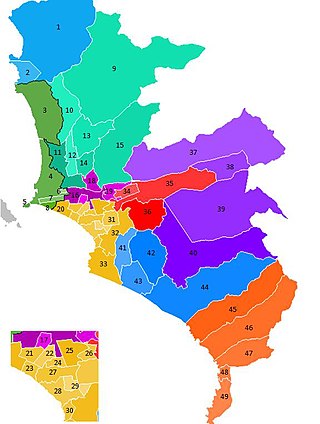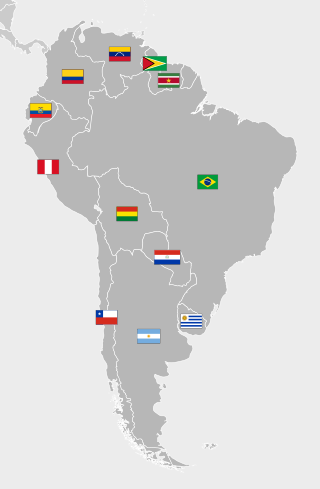Lincoln most commonly refers to:

Lima, founded in 1535 as the Ciudad de los Reyes, is the capital and largest city of Peru. It is located in the valleys of the Chillón, Rímac and Lurín Rivers, in the desert zone of the central coastal part of the country, overlooking the Pacific Ocean. The city is considered the political, cultural, financial and commercial center of Peru. Due to its geostrategic importance, the Globalization and World Cities Research Network has categorized it as a "beta" tier city. Jurisdictionally, the metropolis extends mainly within the province of Lima and in a smaller portion, to the west, within the Constitutional Province of Callao, where the seaport and the Jorge Chávez Airport are located. Both provinces have regional autonomy since 2002.

The Viceroyalty of Peru, officially known as the Kingdom of Peru, was a Spanish imperial provincial administrative district, created in 1542, that originally contained modern-day Peru and most of the Spanish Empire in South America, governed from the capital of Lima. Peru was one of the two Spanish viceroyalties in the Americas from the sixteenth to the eighteenth centuries.

Callao is a Peruvian seaside city and region on the Pacific Ocean in the Lima metropolitan area. Callao is Peru's chief seaport and home to its main airport, Jorge Chávez International Airport. Callao municipality consists of the whole Callao Region, which is also coterminous with the Province of Callao. Founded in 1537 by the Spaniards, the city has a long naval history as one of the main ports in Latin America and the Pacific, as it was one of vital Spanish towns during the colonial era. Central Callao is about 15 km (9.3 mi) west of the Historic Centre of Lima.
Callao is a seaside city, port and region in the Lima metropolitan area of Peru.
San Martín or San Martin may refer to:

The Lima and Callao Metro is a rapid transit system that serves the cities of Lima and Callao, which make up the Lima metropolitan area. The existing metro lines currently link the district of Villa El Salvador in the south of Lima with San Juan de Lurigancho in the northeast of the city, as well as a 5km segment in the east of the metro area. Furthermore, there are four additional lines planned for the network.

Lima Province is located in the central coast of Peru and is the only province in the country not belonging to any of the twenty-five regions, thus being quasi-autonomous. Its capital is Lima, which is also the nation's capital.

The Lima Metropolitan Area is an area formed by the conurbation of the Peruvian provinces of Lima and Callao. It is the largest of the metropolitan areas of Peru, the seventh largest in the Americas, the fourth largest in Latin America, and among the thirty largest in the world. The conurbation process started to be evident in the 1980s.
Santo Domingo is the capital and largest city of the Dominican Republic.
Santo Tomás is Spanish for Saint Thomas. Santo Tomas may also refer to:

Avenida Corrientes is one of the principal thoroughfares of the Argentine capital of Buenos Aires. The street is intimately tied to the tango and the porteño sense of identity. Like the parallel avenues Santa Fe, Córdoba, and San Juan, it takes its name from one of the Provinces of Argentina.

The club is the first soccer representative of the first port of Peru, Callao, which laid the foundations for future Chalacos clubs, going from being a school club to being a professional club, gaining recognition, prestige and trust among fans of the Callao, from Lima and Peru, since today there are many clubs with the name of Atlético Chalaco, but only one is the original and traditional. [At present, Atlético Chalaco is called the "Historical Soccer Heritage of the Constitutional Province of Callao ".
A Peruvian postal code is a five-digit string that comprises part of a postal address in Peru. Prior to 2011, only the major cities of Lima and Callao used postal codes. However, in February 2011 a nationwide system was implemented which employs a five-digit numeric format. Similar to the postal codes of Mexico, Brazil, Australia, the United States, and elsewhere, postal codes in Peru are strictly numerical, using only numbers.

This is a gallery of flags of South American countries and affiliated international organizations.
Simón Bolívar (1783–1830) was the Venezuelan leader of independence movements in several South American countries.

Rodolfo José Fischer Eichler, nicknamed Lobo was an Argentine international association football player of German-Brazilian descent. His tenacity awarded the tall attacker with the nickname El Lobo, the "Wolf". With CA San Lorenzo de Almagro in Buenos Aires he won three championships and he remained one of the foremost strikers in the club's history. Among others, he also played for Botafogo FR in Brazil and CD Once Caldas in Colombia.
Atlético, Spanish for athletics, or Athletico in English, may refer to:
The Liga Regional de Lima y Callao, the second division of Peruvian football (soccer) in 1941, and the third division of Peruvian football (soccer) in 1942 until 1950. The tournament was played on a home-and-away round-robin basis.








